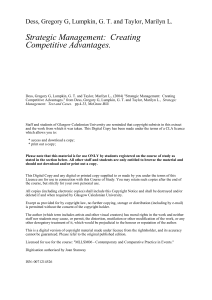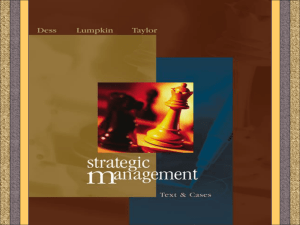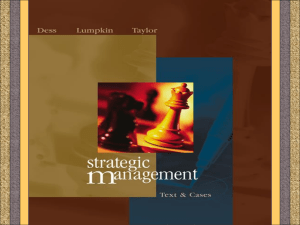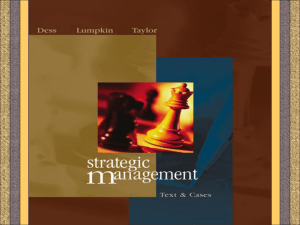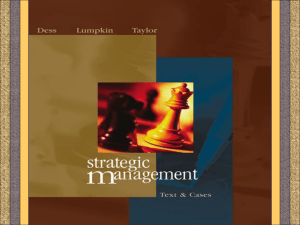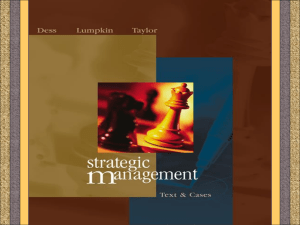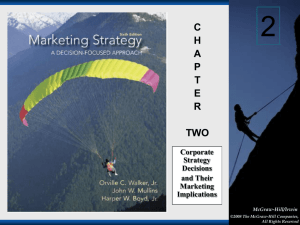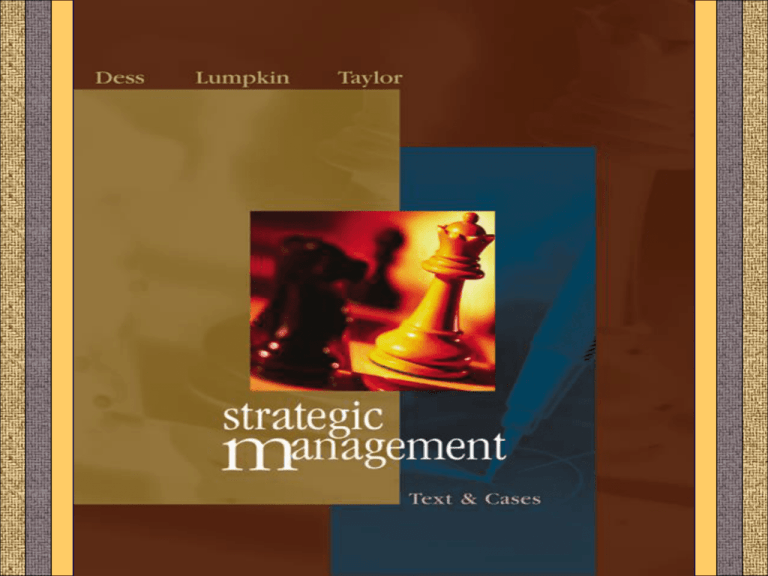
6-1
STRATEGIC MANAGEMENT
CHAPTER 6
Gregory G. Dess and G. T. Lumpkin
Chapter 6
Corporate-Level
Strategy: Creating
Value Through
Diversification
McGraw-Hill/Irwin
Copyright © 2004 by The McGraw-Hill Companies, Inc. All rights reserved.
6-3
Learning
Objectives
After studying this chapter, you should have
a good understanding of:
• How managers can create value through diversification
• The reasons why many diversification efforts fail
• How corporations can use related diversification to
achieve synergistic benefits through economies of scope
and market power
• How corporations can use unrelated diversification to
attain synergistic benefits through corporate
restructuring, parenting, and portfolio analysis
• The various means of engaging in diversification—
mergers and acquisitions, joint ventures/strategic
alliances, and internal development
• Managerial behaviors that can erode the creation of value
STRATEGIC MANAGEMENT
CHAPTER 6
Gregory G. Dess and G. T. Lumpkin
6-4
Exhibit 6.1
(adapted)
Diversification and Corporate
Performance: A Disappointing History
• A study conducted by Business Week and Mercer
Sources: Lipin, S. & Deogun,
N. 2000. Big merges of the
90’s prove disappointing to
shareholders. Wall Street
Journal, October 30: C1; A
study by Dr. G. William
Schwert, University of
Rochester, cited in Pare, T. P.
1994. The new merger boom.
Fortune, November 28:96; and
Porter, M.E. 1987. From
competitive advantage to
corporate strategy. Harvard
Business Review, 65(3):43.
Management Consulting, Inc., analyzed 150 acquisitions
that took place between July 1990 and July 1995. Based on
total stock returns from three months before, and up to
three years after, the announcement:
30 percent substantially eroded shareholder returns.
20 percent eroded some returns.
33 percent created only marginal returns.
17 percent created substantial returns.
• A study by Salomon Smith Barney of U.S. companies
acquired since 1997 in deals for $15 billion or more, the
stocks of the acquiring firms have, on average, underperformed the S&P stock index by 14 percentage points
and under-performed their peer group by four percentage
points after the deals were announced.
STRATEGIC MANAGEMENT
CHAPTER 6
Gregory G. Dess and G. T. Lumpkin
6-5
Exhibit 6.2
(adapted)
Creating Value through Related
Diversification
Economies of Scope
(Efficiencies of operating two or more businesses
within the same firm)
Leveraging Core Competences
• 3M leverages its competences in adhesives
technologies to many industries, including
automotive, construction, and telecommunications
Sharing Activities
• McKesson, a large distribution company, sells
many product lines such as pharmaceuticals and
liquor through its super warehouses
STRATEGIC MANAGEMENT
CHAPTER 6
Gregory G. Dess and G. T. Lumpkin
6-6
Exhibit 6.2
(adapted)
Creating Value through Related
Diversification
Market Power
Pooled Negotiating Power
• The Times Mirror Company increases its power
over customers by providing “one-stop shopping”
for advertisers to reach customers through
multiple media in several huge markets
Vertical Integration
• Shaw Industries, a carpet manufacturer, increases
its control over raw materials by producing much
of its own polypropylene fiber, one of its key
inputs
STRATEGIC MANAGEMENT
CHAPTER 6
Gregory G. Dess and G. T. Lumpkin
6-7
Exhibit 6.2
Creating Value through
Unrelated Diversification
(adapted)
Corporate Restructuring and Parenting
• Cooper Industries adds value to its acquired businesses by
performing such activities as auditing their manufacturing
operations, improving their accounting activities, and
centralizing union negotiations
Portfolio Analysis
• Novartis uses portfolio analysis to improve many key
activities, including resource allocation as well as reward
and evaluation systems.
Creating Synergy Across the Business Units
• Richard Branson creates synergy across various unrelated
and largely independent businesses by linking them
through branding (Virgin).
STRATEGIC MANAGEMENT
CHAPTER 6
Gregory G. Dess and G. T. Lumpkin
6-8
Exhibit 6.3
Simplified Stages of Vertical Integration:
Shaw Industries
Polypropylene
Fiber Production
Raw Materials
Carpet Manufacturing
Manufacturing of final product
Backward Integration
STRATEGIC MANAGEMENT
CHAPTER 6
Retail Stores
Distribution
Forward Integration
Gregory G. Dess and G. T. Lumpkin
6-9
The Benefits and Risks of Vertical Integration
Benefits
Secures a source of raw
materials or
distribution channels
Protection and control
over valuable assets
Access to new business
opportunities
Risks
Costs associated with
increased overhead and
capital expenditures
Loss of flexibility resulting
from large investments
Problems associated with
unbalanced capacities
along the value chain
Simplified procurement Additional costs associated
and administrative
with more complex
procedures
activities
STRATEGIC MANAGEMENT
CHAPTER 6
Gregory G. Dess and G. T. Lumpkin
6-10
Exhibit 6.5
The BCG Portfolio Matrix
22%
Stars
Question Marks
20%
18%
16%
14%
12%
10%
Cash Cows
8%
Dogs
6%
4%
Relative Market Share
0.1X
1X
1.5X
2X
0
10X
2%
Notes:
1. Each circle represents one of the corporation’s business units. The size of the circle represents the relative size of the business unit in terms of revenues.
2. Relative market share is plotted as a logarithmic scale to be consistent with experience curve effects. This is very similar to learning curves and central
to the BCG growth share matrix.
3. Relative market share is measured by the ratio of the business unit’s size to that of its largest competitor.
Gregory G. Dess and G. T. Lumpkin
STRATEGIC MANAGEMENT CHAPTER 6
6-11
Exhibit 6.6
The top ten mergers
Below are the world’s biggest mergers. Listed are the partners, each deal’s status
or date of completion, and values in billions.
Sources:
Thomson
Financial
Securities
Data; AP
Wire Reports
Partners
Date
1. Vodafone AirTouch PLC-Mannesmann AG
April 12, 2000
$161
2. Pfizer Inc.-Warner-Lambert Co.
June 19, 2000
$116
3. America Online-Time Warner
January 11, 2001
$111
4. Exxon Corp.-Mobil Corp.
Nov. 30, 1999
$81
5. (tie) Glaxo Wellcome PLC-SmithKline Beecham
PLC
December 27, 2000
$72
5. (tie) SBC Communications Inc.-Ameritech
Oct. 8, 1999
$72
7. Vodafone Group PLC-Airtouch Communications Inc.
June 30, 1999
$69
8. Bell Atlantic Corp.-GTE Corp. (now Verizon)
May 30, 2000
$60
9. Total Fina-Elf Aquitaine (now Total Fina Elf S.A.)
Feb. 9, 2000
$54
10. Viacom Inc.-CBS Corp.
May 4, 2000
$50
STRATEGIC MANAGEMENT
CHAPTER 6
Value ($ billions)
Gregory G. Dess and G. T. Lumpkin

